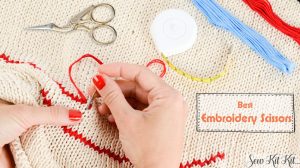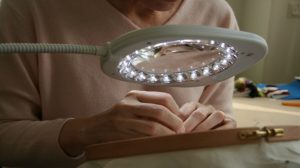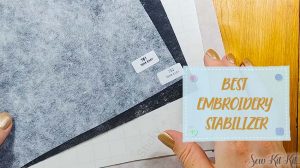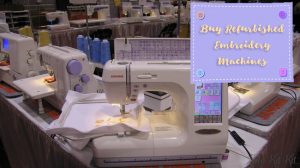Last Updated on January 10, 2023
Are you new at embroidery and need a machine? Here is our guide to the best embroidery machines for beginners.
When you buy through links on our site, we may earn an affiliate commission. As an Amazon Associate I earn from qualifying purchases.
It is hard enough to get into embroidery without having to deal with all the complicated specifications and features of an advanced embroidery machine.
Embroidery is a very delicate and intricate type of art and some machine aspects will influence a lot on the final project, like the size of the working area and connectivity.
Others are a useful plus, but not a must, like an automatic needle threader. Some, on the other hand, are not necessary for home use at all, such as a high sewing speed of 900 stitches per minute.
We are here to help you navigate these differences and get the best embroidery machine for beginners for your needs.
The 8 Best Embroidery Machines for Beginners
| Image | Title | Buy |
|---|---|---|
 Top
Top | Brother PE800 Embroidery Machine, 138 Built-in Designs, 5" x 7" Hoop Area, Large 3.2" LCD Touchscreen, USB Port, 11 Font Styles | Check Price! |
 Top
Top | Brother SE1900 Sewing and Embroidery Machine, 138 Designs, 240 Built-in Stitches, Computerized, 5" x 7" Hoop Area, 3.2" LCD Touchscreen Display, 8 Included Feet | Check Price! |
 Top
Top | Brother PE535 Embroidery Machine, 80 Built-in Designs, 4" x 4" Hoop Area, Large 3.2" LCD Touchscreen, USB Port, 9 Font Styles | Check Price! |
 Top
Top | Brother PE550D Embroidery Machine, 125 Built-in Designs Including 45 Disney Designs, 4" x 4" Hoop Area, Large 3.2" LCD Touchscreen, USB Port, 9 Font Styles | Check Price! |
 Top
Top | Brother SE600 Sewing and Embroidery Machine, 80 Designs, 103 Built-In Stitches, Computerized, 4" x 4" Hoop Area, 3.2" LCD Touchscreen Display, 7 Included Feet | Check Price! |
 Top
Top | EverSewn Sparrow QE Professional Sewing and Quilting Machine - 8Û Throat - 70 Stitch Patterns - Intuative Control Panel, White | Check Price! |
1. Brother PE800
- 138 Built-in designs: Featuring 138 built-in embroidery designs including scrollwork, florals and quilt patterns, the PE800 has numerous options to allow your creativity to flourish
- 11 Built-in fonts: 7 English, 3 Japanese, and 1 Cyrillic font styles are perfect for monogramming and lettering
- USB Port: The PE800s USB port allows you to import your embroidery designs into your machines built-in memory
- Large color touchscreen: The large 3.2 inch LCD color touchscreen allows you to preview your designs before embroidering
- 5 X 7 Embroidery field: This embroidery-only machine comes with an embroidery foot and a 5 x 7 inch embroidery hoop perfect for stitching larger designs
If you are just entering the embroidery world, prepare yourself to hear this name a lot: Brother. This is a very reliable brand, they have the expertise and knowledge to deliver the finest embroidery machines you can get.
The problem is they have so many products that it can be hard to understand the differences between them. The best thing is to notice the numbers and letters, they will tell you the model and line of the device.
All “PE” Brother machines are embroidery only, they don’t have a sewing feature. This one is the best one for beginners, it comes with over a hundred built-in designs and eleven fonts.
The colored, touch-screen LCD display and USB port make it a fantastic investment well suited for home use.
The software is easy to use and the machine will do almost all the work for you, building patterns up to 5×7 inches big.
2. Brother SE1900
- 138 Built-in designs: The SE1900 comes with 138 Built-in designs and 11 embroidery fonts perfect for monogramming
- Advanced needle threader and drop-in top bobbin: This sewing and quilting combo machine includes an advanced needle threading function that easily pushes the thread through the needle with the press of a lever and a jam resistant drop-in top bobbin
- 240 Built-in sewing stitches: The SE1900 features 240 Built-in sewing stitches including 10 styles of auto-size buttonholes
- Large color touchscreen: Preview your designs and browse editing options on the large full color, 3.2 inch LCD touchscreen display
- 5 X 7 Embroidery field: This Brother combo embroidery and sewing machine is built with a 5 x 7 Embroidery field for larger designs with an included hoop and 8 sewing f
Some may say that the 1900 is not a beginner’s machine since it is a powerful, fast, and versatile device. We think, however, that even beginners appreciate quality, built, and ease of use!
Unlike the “PE” series, the “SE” ones are a mix of embroidery and sewing machines – called combination machines. That means the module pops up and you can use it regularly to sew clothing or anything.
It comes with all the accessories you may need, such as embroidery, zipper, and buttonhole foot. The built-in LED light provides perfect lighting even in dim conditions and the automatic needle
header guarantees you don’t spend hours and hours trying to slip the strand inside the needle.
The embroidery field is large, 5×7 inches, and there are many lettering and original embroidery designs in it.
The software is intuitive and the whole machine is easy to use, truly beginner-friendly!
3. Brother PE535
- 80 Built-in designs: The PE535 features 80 built-in embroidery designs including kids designs, holiday, floral and many more
- 9 Built-in fonts: 6 English and 3 Japanese lettering fonts allow you to personalize your creations
- USB Port: The USB port allows you to upload and store your own embroidery designs to your PE535s built-in memory
- Large color touchscreen: An expansive 3.2 inch LCD color touchscreen allows you to preview your designs before stitching
- 4 X 4 Embroidery field: This Brother embroidery machine is built with a 4 x 4 Embroidery field and includes a hoop
- The PE535 is an embroidery machine and does not function as a traditional sewing mach
This is another model that is to be used strictly as an embroidery machine. It includes eighty embroider designs of its own, as you can also upload your patterns via a USB port.
One of the features that make the PE Brother machines so good is the ability they have to back up automatically.
That means that if you have a power cut or run out of thread the device will remember where in the pattern they were. The backup also lets you delete stitches easily and resume from where you want.
The embroidery area is smaller than other models – 4×4 inches, so keep that in mind when getting patterns.
4. Brother PE550D
- 125 Built-in designs: Featuring 125 Built-in designs including 45 Disney designs, the PE550D allows you to bring magic to any project
- 9 Built-in fonts: Personalize your projects with 6 English and 3 Japanese lettering font styles
- USB Port: Import your embroidery designs into your PE550Ds built-in memory through the USB port
- Large color touchscreen: Preview your designs before embroidering with the large, 3.2 inch LCD color touchscreen display
- 4 X 4 Embroidery field: This embroidery-only machine comes with a 4 x 4 hoop, an embroidery foot and built-in alignment tools
- The PE550D is an embroidery machine and does not function as a traditional sewing mach
Most Brother machines can be used straight out of the box, and the PE550D is no exception.
It sews four hundred stitches per minute, more than enough for home use, and it comes with over a hundred embroidery designs. Not any designs, however, but Disney ones!
If you have a little one that is obsessed with Mickey, this is the machine to get. The display is touchscreen and bigger than most, with 3.2 inches and perfect color recreation.
This is key since it lets you see the design and thread colors as they really are and avoids mistakes. Lettering fonts are also added, and you can make them small, medium, or big.
5. Brother SE600
- 80 Built-in designs: The SE600 comes with 80 built-in designs and 6 embroidery lettering fonts for personalizing your projects
- Automatic needle threader and drop-in top bobbin: This sewing and embroidery combo machine includes an automatic needle threader that perfectly pushes the thread through the needle and a convenient, jam resistant drop-in top bobbin
- 103 Built-in sewing stitches: This machine features 103 sewing stitches including 10 styles of auto-size buttonholes. Maximum Sewing Speed (Stitches per minute)- 710
- Large color touchscreen: The Brother SE600 computerized sewing and embroidery machine features a large 3.2 LCD color touchscreen allowing you to preview your designs before stitching
- 4 X 4 Embroidery field: This computerized combo machine is built with a 4 x 4 Embroidery field with an included hoop, embroidery arm and 7 sewing f
As you can see from the initials on this model, this is a combination embroidery machine. Brother’s website carries a series of videos showing how to use their machines, and you can find the SE600 one there as well.
Even though you have to follow a few steps to transform the embroidery machine into a sewing one and vice versa, it is not that complicated at all.
This is a more compact and simpler combination machine comparing to the SE1900, and also more affordable. It still comes with all the features you need, however, like display, USB port, built-in patterns, and stitches.
It also lets you customize designs on the screen, and you can even move parts of the drawings and change thread colors. A real treat.
6. EverSewn Sparrow QE
- Modern sewing and quilting machine with professional sewing features – ideal for advanced sewers and quilters
- Beautiful stitch Quality, knee lift and an 8-inch throat space – perfect for larger projects or quilts
- The Sparrow QE offers professional Tools at a very competitive price, offering over 70 stitch patterns, speed control and a built-in thread cutter
- Selecting and changing Stich settings is quick and simple with the intuitive and easy-to-navigate Interface
- Slide-on table and a special quilting deluxe foot kit can be purchased separat
Are you a fan of futuristic devices full of features? Then the EverSewn Sparrow X will definitely catch your eye. You can control the Sparrow with an app on your phone and even do so from a different room.
The app also serves to add new designs and to edit patterns, making it very easy to include new motifs. Since the machine has wifi you can expect to get important notifications on your devices, such as time remaining and the need for a new thread.
This is the best embroidery machine for beginners to edit and rearrange patterns, allowing for your creativity to fly!
As a plus, this is also a sewing machine – great if you don’t want to have two different gadgets in the house.
7. SINGER Quantum Stylist 9960
- SINGER COMPUTERIZED SEWING MACHINE: The SINGER Quantum Stylist 9960 portable sewing machine has loads of ease-of-use features to allow you to fulfill your creative dreams Has a large selection of stitches including basic, stretch and decorative stitches for fashion sewing, quilting, home decor and crafting There’s even a selection of fonts to personalize projects
- AUTOMATIC NEEDLE THREADER: Threading the machine is so easy that you can have the entire machine threaded, from the spool to the needle’s eye, in seconds The built-in needle threader threads the eye of the needle for you, eliminating eye strain and frustration
- BEST SEWING MACHINE: The SINGER Quantum Stylist 9960 sewing machine has 600 Built-In Stitches including 5 Alphanumeric Fonts and 13 built-in 1-Step Buttonholes with Exclusive Buttonhole Underplate It also has Mirror Imaging and Stitch Elongation providing even more creative possibilities
- HIGH-SPEED SEWING MACHINE: The SINGER Quantum Stylist 9960 sewing machine has a maximum sewing speed of 850 stitches-per-minute, projects can be sewn quickly
- SEWING MACHINE ACCESSORIES: A variety of presser feet are included with the sewing machine: All-Purpose Foot, Zipper Foot, Buttonhole Foot with Underplate, Button Sewing Foot, Blind Hem Foot, Satin Stitch Foot, Open Toe Foot, Overcasting Foot, Darning and Embroidery Foot, Rolled Hem Foot, Cording Foot, Straight Stitch/Quilting Foot, Even Feed / Walking Foot 110 volt machine designed for United States and Canadian use o
The Singer 9960 is a sewing machine first and an embroidery machine second. That makes it ideal if you need to sew and also want to try embroidery.
It is a very sturdy machine, and the metal frame is well-built and durable. It comes with built-in stitches and it is incredibly fast – up to 850 stitches. It does not come with designs, but you can do freehand embroidery.
This machine is most suited for sewists who want to embroider details on small patches of clothes, handkerchiefs, tablecloths, and other small items.
8. Janome Embroidery Machine
- 73 built-in designs | 3 fonts for monogramming | Dust cover included
- Embroidery format: .JEF | Maximum embroidery size: 5.5” x 5.5” | LCD touchscreen
- Included Hoop: 5 x 5 | Design transfer via USB |Compact and portable; easy-to-carry handle
- Top Loading Full Rotary Hook Bobbin | Automatic Thread Tension Control | 9mm Maximum Stitch Width
- AcuFeed Feed System | Auto De-Clutch Bobbin Winding | 13 One-Step Buttonholes | Automatic Built-in Needle Threa
Even though Janome is not the most renowned name out there, it is still a reliable and quality brand.
Many sewists swear by this machine and prefer it over the Brother ones. It has some nifty features, such as a thread breakage sensor that lets you know right away if the filament breaks and the ability to size the patterns up or down.
It comes with seventy-three designs and three monogramming fonts, plus needles, hoops, and bobbins.
The embroidery area is large too, 5×5 inches large, and patterns are editable. You can enlarge them, reduce them and even mirror them – great for reflection designs.
Buying Guide for the Best Embroidery Machine for Beginners
Combined or not
The first thing for a beginner to consider is if you are using the machine for embroidery only or if it would be beneficial to also have a sewing machine.
This decision will narrow down your pool of choices tremendously. If you think you want to sew as well but are worried that a combination machine will be too complicated, don’t fret.
Most computerized machines change into sewing mode with just a click on the screen, so you’ll be fine.
Hoop size
The hoop size determines how big your embroidery pattern will be. The machine specifications will tell you that, but we have an extra tip. If the hoop area is 4×4 inches, for example, it will deliver designs slightly smaller than 4×4.
That goes for all sizes, keep in mind the final product will be marginally smaller. It is a good idea to check patterns you are interested in before purchasing the machine and see how big they are.
Throat width
The throat width is a feature that is not much discussed but makes a difference when you are embroidering.
This refers to the distance between the body of the machine and the needle. The smaller that distance, the harder it is to embroider the fabric.
Narrow throats can be frustrating to use and require you to constantly adjust the cloth or fabric. You want at least 9 inches there.
Design editing
If you dream of altering and coming up with your own designs you may be disappointed with some embroidery machines. Not all of them allow you to tinker with the patterns, and if that is important for you, look for this special feature.
Fonts
While many people look for the patterns and designs that come with the machine, not everyone pays attention to the fonts.
Lettering is a big part of embroidery, and oftentimes it ties up a design nicely. Check how many fonts are included in the software.
Display
A touchscreen, colored display is not only a novelty on embroidery machines. Due to the nature of the project, you need to clearly see the colors of which thread, where do they change, and the color scheme as a whole.
Poorly constructed displays may affect the end result of your design.
Embroidery Machines Frequently Asked Questions
In what format embroidery patterns come?
We talked a lot about built-in patterns and the possibility to add new designs through a USB port or app. But in what format they come and are they compatible with embroidery machines?
You can easily recognize the format by the file name extension, and the most common one is PES, used by Brother machines. Janome uses SEW and SInger uses XXX.
What weight bobbin thread do embroidery machines need?
First of all, the bobbin thread is a light thread used in embroidery machines.
It is much lighter than regular thread, and it makes the back of the design less dense than the front. Embroidery involves a lot of back and forth to make the patterns, and regular thread can give a bulky feeling to the fabric.
The most common weights are 40 and 60, with the latter being the thinner one. They are both equally strong, however, since they are made from polyester.
What types of fabric can I use with my embroidery machine?
Embroidery works better on naturally woven fabrics, like cotton, linen, silk, and wool. The way they are constructed ensures a robust surface that supports decorative patterns well.

![Read more about the article How to Separate an Embroidery Floss [Guide]](https://www.sewkitkit.com/wp-content/uploads/2019/07/How-to-Separate-an-Embroidery-Floss-7-300x168.jpg)




![Read more about the article How to Embroider Stretchy Material [Guide]](https://www.sewkitkit.com/wp-content/uploads/2018/05/How-to-Embroider-Stretchy-Material-300x168.jpg)